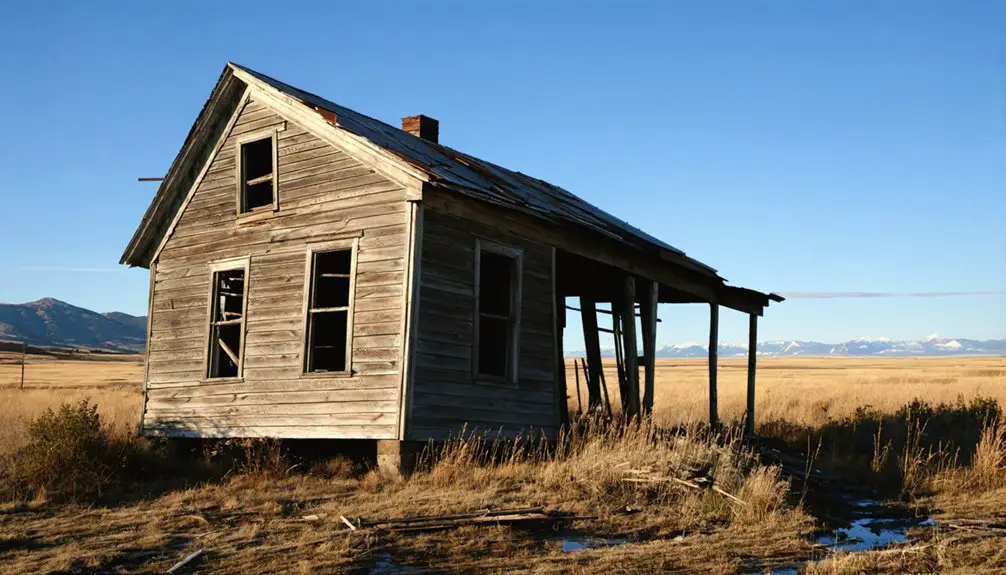You’ll find Quartz, Montana nestled in the Pioneer Mountains, where the Vipond family staked the first claims in the late 1860s. This silver mining boomtown flourished around the Lone Pine Mine, which produced $33,000 in silver monthly at its peak through a 25-stamp mill and 1,800-foot-deep workings. Though the 1907 financial panic dealt a devastating blow, the ghost town’s weathered cabins and mining ruins tell a compelling story of Montana’s mineral-rich past.
Key Takeaways
- Quartz Hill Mining District emerged in the late 1860s through claims staked by the Vipond family in Montana’s rich mineral territory.
- The district’s crown jewel, the Lone Pine Mine, produced $33,000 in silver monthly with a 600-foot shaft and 25-stamp mill.
- Ponsonby Mining Camp featured basic wooden cabins without running water, housing miners who endured harsh living conditions.
- The 1872 road to Dewey and later railroad connections transformed the district’s ability to transport valuable ore efficiently.
- Economic decline, particularly after the Panic of 1907, led to mine closures and the area’s eventual transformation into a ghost town.
The Birth of a Mining District
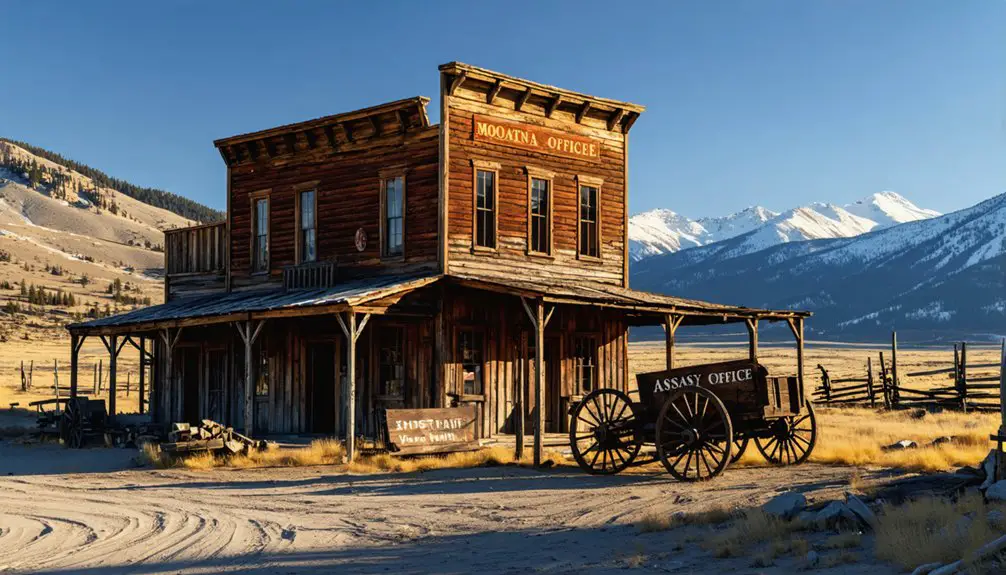
While Montana’s Pioneer Mountains held numerous mineral deposits, the Quartz Hill Mining District emerged as a significant mining region in the late 1860s when the Vipond family staked their initial claims.
You’ll find this district operated as a quasi-municipal entity, establishing its own mining legislation and local customs independent of federal oversight. When transportation challenges threatened progress, they built a road to Dewey in 1872, opening new possibilities for ore shipment.
The district’s formation reflected the spirit of frontier self-governance, where miners created their own rules for claim locations and work requirements. Like other Montana mining operations, they initially focused on silver mining efforts, though with limited success. Following patterns seen in the U.S. General Mining Act, the district allowed private claim stakes on federal lands.
Miners on America’s frontier forged their own destiny, establishing local regulations that governed both land claims and labor standards.
Despite occasional labor disputes, the area’s rich silver deposits attracted steady development. The district’s success grew further when the arrival of railroads in the 1870s and 1880s brought essential capital, equipment, and workers to the region.
Early Mining Claims and Discoveries
Although the Pioneer Mountains held various mineral riches, John Vipond’s 1868 claim at Quartz Hill marked the first documented mining operation in the area. His brother William staked an adjacent claim the following year, while Colonel Washington Black independently established his presence in the district.
Early prospecting techniques focused on both placer gold from creek gravels and quartz veins in bedrock. Miners used rockers and sluices to process the gravel deposits efficiently. You’ll find that mining claim disputes were minimized through regulated claim boundaries and required assessment work.
When Joseph Vipond and local miners built a road to Dewey in 1872, they solved vital transportation challenges. The district’s success attracted experienced miners, including Scandinavian immigrants who brought valuable expertise.
Rise of the Lone Pine Mine
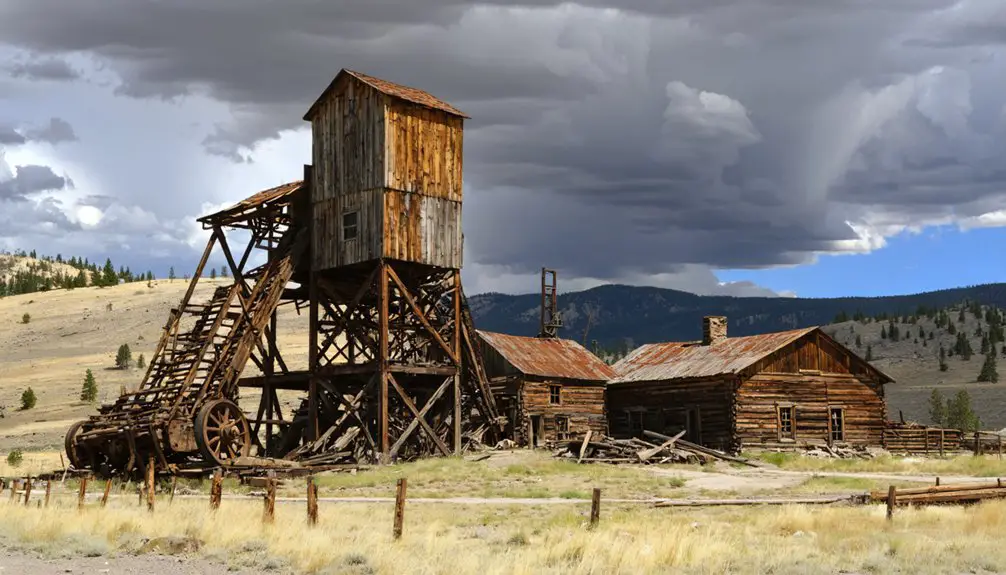
Among the district’s many mines, the Lone Pine Mine emerged as the crown jewel of the Quartz Hill Mining District in the late 1870s.
You’ll find its legacy written in the extensive mining techniques used to extract precious metals, including a 600-foot inclined main shaft and complex network of underground workings. The mine’s sophisticated ore extraction methods and 25-stamp mill generated an impressive $33,000 in silver monthly during peak production.
- The mine’s infrastructure included multiple working levels, reaching depths of 1,800 feet.
- Advanced mining techniques combined vertical shaft sinking with horizontal drifting.
- The discovery of the West Lone Pine shoot in 1928 breathed new life into operations.
This powerhouse of mineral wealth supported the town of Ponsonby and dominated local silver production until the 1960s.
Life in Ponsonby Mining Camp
Despite its connection to the prosperous Lone Pine Mine, life in Ponsonby Mining Camp remained harsh and primitive throughout its existence. You’d find yourself living in hastily-built wooden cabins without proper foundations, sharing cramped spaces with fellow miners from diverse backgrounds.
The miner living conditions reflected the camp’s temporary nature – no running water, basic sanitation, and limited resources. Like many mining settlements before the Silver Panic of 1893, these camps struggled to maintain stable populations and infrastructure. Miners initially used placer mining methods to extract gold from the creeks using simple tools and equipment.
The community dynamics centered around survival and mutual support. You’d join informal mining groups to share tools and information, while women ran boarding houses and maintained households.
Your daily life would revolve around exhausting physical labor, with entertainment limited to saloon gatherings and card games. The camp’s isolation, harsh weather, and unreliable supply lines made everything from food to mining tools expensive and hard to obtain.
Transportation and Infrastructure Development
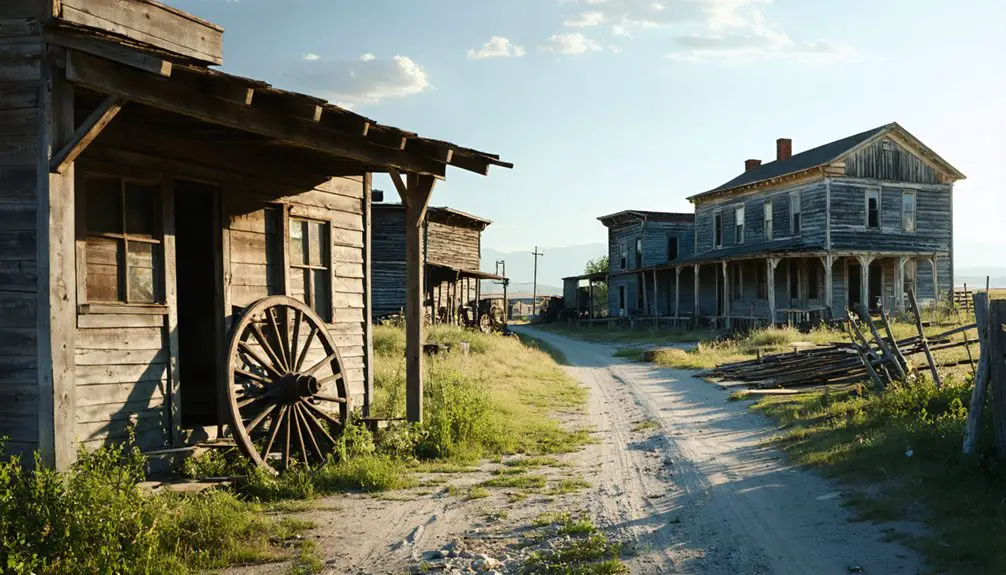
You’ll find the critical turning point in Quartz Hill’s mining operations came in 1872 when Joseph Vipond and local miners constructed an important road connecting the mines to the town of Dewey.
This road network proved essential for both ore transport and supplying the remote mountain mining sites, though its crude nature and limited reach meant additional solutions were needed. The area’s accessibility improved when it was positioned along what would become Montana Highway 1, providing better connections to nearby towns. The town’s development accelerated rapidly with thirteen saloons established to serve the growing mining population.
As mining activities expanded, the transportation infrastructure grew to include wooden aerial tramways that could move up to 200 tons of ore daily using steel cables and timber towers, greatly improving the district’s production capabilities.
Road to Dewey
The construction of the Road to Dewey in 1872 marked a pivotal development in Montana’s mining infrastructure, connecting the rich silver deposits of Quartz Hill to the emerging settlement of Dewey.
Joseph Vipond and local miners undertook this essential road construction project to solve their mining transportation challenges across the rugged Pioneer Mountains terrain.
You’ll find the road’s historic significance in these key aspects:
- Enabled monthly silver shipments worth $33,000 from operations like the Lone Pine mill
- Supported the region’s mining boom from 1877 to 1895 by providing reliable ore transport
- Created a critical lifeline for workers, supplies, and equipment between Dewey and the mining camps
The road’s legacy lives on today, though it’s transformed from a commercial artery into a recreational path for ghost town explorers and rock hounds.
Mining Transport Networks
While early placer miners relied on simple water diversions and pack animals, Montana’s shift to large-scale lode mining demanded sophisticated transport networks.
You’ll find that mining logistics evolved dramatically with the arrival of major railroads in the 1880s, including the Northern Pacific reaching Helena in 1883 and Butte by 1893.
Before rail expansion, you’d have seen mule trains hauling massive stamp mills and equipment over treacherous mountain passes.
Eight-foot-wide wagon roads connected remote mines to processing sites, while narrow gauge spurs aided ore transport between mills positioned on steep embankments. The Montana Mine & Mill team faced challenging terrain, having to cross Goat Creek using fallen trees.
The rail revolution transformed Montana’s mining capabilities – you could now ship copper ore as far as Wales for smelting.
This robust transportation infrastructure attracted crucial capital investment, enabling the territory’s mining operations to flourish on an industrial scale.
Peak Mining Operations and Production
During peak mining operations in the late 19th century, you’d have found the Lone Pine Mill processing gold-bearing quartz from multiple veins in the district, with ore grades reaching up to 0.23 ounces of gold per ton.
Major ore discoveries in the oxidized, free-milling quartz veins helped drive the district’s production to over $200,000 worth of gold throughout its active period.
The district’s monthly production records reflected the typical boom cycles of Montana mining towns, with higher yields coming from near-surface deposits where gold was more readily recoverable through existing milling processes.
Lone Pine Mill Operations
After establishing the Lone Pine Mine in the late 1870s, operators constructed a 25-stamp mill that became central to Quartz’s mining success.
During its early years, the mill consistently produced $33,000 in silver monthly, supporting the adjacent town of Ponsonby. Similar to the region’s lumber company camps, workers lived on-site in dedicated housing facilities.
Lone Pine operations expanded considerably after 1928 when miners discovered the West Lone Pine shoot, leading to decades of steady silver production.
- The mill’s infrastructure included a 600-ft inclined shaft with multiple levels, allowing efficient silver recovery from depths reaching 1,800 feet.
- Advanced milling processes evolved to handle various metals, including gold, copper, lead, and zinc.
- The operation’s production peaks spanned three major periods: 1867-1895, 1908, and 1933-1962, contributing to over 57,000 tons of ore from the district.
Major Ore Discoveries
The rich quartz veins near McClellan Gulch marked the beginning of Quartz’s most significant mineral discoveries.
You’ll find that the Glencoe mine’s 1,000-foot lode, which sold for $10,000, demonstrated the area’s incredible potential. As mining techniques evolved from simple placer operations to sophisticated underground extraction, prospectors uncovered complex ore bodies containing gold mixed with silver, copper, and other minerals.
The challenges of ore processing led to rapid technological advancement.
You’ll appreciate how the early quartz mills, despite initial setbacks, paved the way for more efficient operations. The introduction of railroad transportation transformed the district’s potential, allowing miners to ship ore to eastern smelters and receive vital supplies.
This infrastructure development helped Quartz capitalize on its mineral wealth, particularly during the peak production years of the 1880s.
Monthly Production Records
Mining production records reveal impressive output levels across Quartz’s peak operational years.
You’ll find the Lone Pine mine‘s 25-stamp mill churned out $33,000 worth of silver monthly during the late 1800s, while ore extraction techniques evolved to handle multiple metals simultaneously.
The district’s production saw notable monthly production fluctuations, yet maintained operations well into the mid-20th century.
- The combined Quartz Hill and Vipond districts processed 57,261 tons of polymetallic ore between 1902-1965
- Silver production peaked in the 1870s-1890s, with a significant revival during the 1920s
- The development of improved transportation routes in 1872 revolutionized ore hauling efficiency, leading to more consistent monthly outputs
These production figures paint a picture of a thriving mining district that adapted and persevered through changing market conditions.
Economic Challenges and Market Influences
While many Western boomtowns faced economic challenges, Quartz’s financial destiny hinged almost entirely on mineral extraction and fluctuating market prices.
You’ll find that this economic vulnerability left the town at the mercy of broader market forces, with local businesses and workers struggling to maintain stability. The mining companies controlled nearly every aspect of the economy through company stores and rigid payroll systems, leaving little room for workers to build independent wealth.
The town’s remote location and poor infrastructure made it difficult to transport minerals efficiently, driving up operational costs. The devastating Panic of 1907 severely impacted mining operations, causing many ventures to shut down completely.
When mineral prices dropped, particularly after market speculation died down, you’d see immediate impacts – mines would close, workers would leave, and the town’s liveliness would drain away until the next promising strike or price surge.
Legacy of Silver and Gold
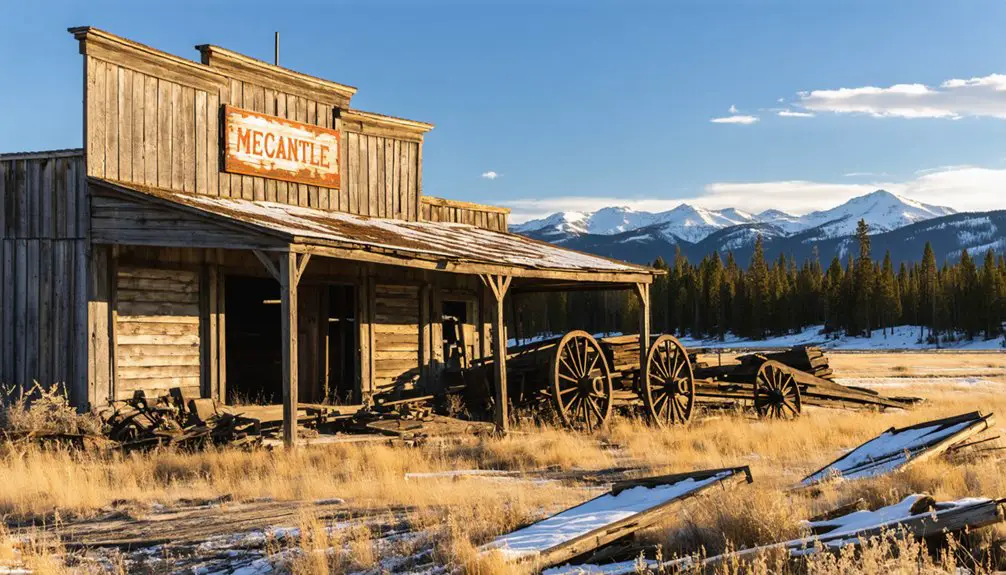
A pivotal discovery along Silver Bow Creek in 1864 by Barker and Party sparked Montana’s transformation from simple placer mining to sophisticated quartz operations.
When gold rush placer deposits dwindled in the late 1860s, the region’s destiny shifted toward deep underground quartz mining, releasing a silver boom that would reshape Montana’s economic landscape.
You’ll find three enduring impacts from this transformative era:
- The establishment of essential transportation networks as mining wealth attracted railroad investment
- The emergence of culturally diverse communities shaped by immigrant miners skilled in hard rock extraction
- The creation of lasting historical sites, where preserved mining structures tell the story of Montana’s mineral wealth
These legacies continue to influence Montana’s identity, from its ghost towns to its modern mining operations.
Modern-Day Ghost Town Remains
Today, Garnet stands as one of Montana’s best-preserved ghost towns, offering visitors an authentic glimpse into the state’s mining past.
You’ll find many original structures still intact, including homes, the Wells Hotel, and Davey’s general store, though a devastating 1912 fire claimed part of the business district.
Thanks to ghost town preservation efforts by the Bureau of Land Management and Garnet Preservation Association, you can explore this historic site through self-guided tours.
The visitor experience remains uncommercial, letting you wander among buildings that seem frozen in time, complete with period furnishings and artifacts.
Interpretive trails and signage help you understand the town’s mining heritage, while the surrounding hiking paths reveal the geographic context of this mountain community’s past.
Frequently Asked Questions
What Dangerous Wildlife Was Commonly Encountered by Miners in Quartz?
You’d face lethal bear encounters in wilderness mining areas, while venomous snake bites posed serious risks. Mountain lions, wolves, and aggressive elk threatened your safety near mining operations.
How Did Miners Handle Medical Emergencies in This Remote Location?
You’d rely on basic first aid from fellow miners, visit makeshift clinics run by traveling doctors, or face long wagon rides to larger towns when seriously injured or ill.
Were There Any Notable Crimes or Lawlessness in Quartz?
You won’t find records of major crime sprees or intensive law enforcement in Quartz – it maintained remarkable order despite its saloons and bawdy houses, unlike some rowdier Montana mining settlements.
What Happened to the Mining Equipment After Operations Ceased?
Like autumn leaves scattered by wind, mining machinery sat abandoned in place, with minimal equipment preservation techniques. You’ll find some was salvaged for scrap, but most simply deteriorated where it stood.
Did Any Famous People Ever Visit or Invest in Quartz?
You won’t find any records of famous visitors or major celebrity investments in this remote mining town. Historical documents show investments came primarily from local prospectors and regional mining companies.
References
- https://www.garnetghosttown.org/history.php
- https://melissawhitneyphotography.com/2020/10/01/the-ghost-towns-of-garnet-and-granite-montana/
- https://www.youtube.com/watch?v=YU0y9_5Ylbg
- https://www.mtghosttowns.com/quartz-hill-vipond
- https://www.mountain-home.com/blog/vacation-planning/guide-montana’s-ghost-towns
- https://www.mininghistoryassociation.org/ButteHistory.htm
- https://mhs.mt.gov/education/textbook/chapter6/Chapter6.pdf
- https://archiveswest.orbiscascade.org/ark:80444/xv647063
- https://pubs.usgs.gov/circ/0007/report.pdf
- https://www.mininghistoryassociation.org/Journal/MHJ-v11-2004-Schure.pdf
